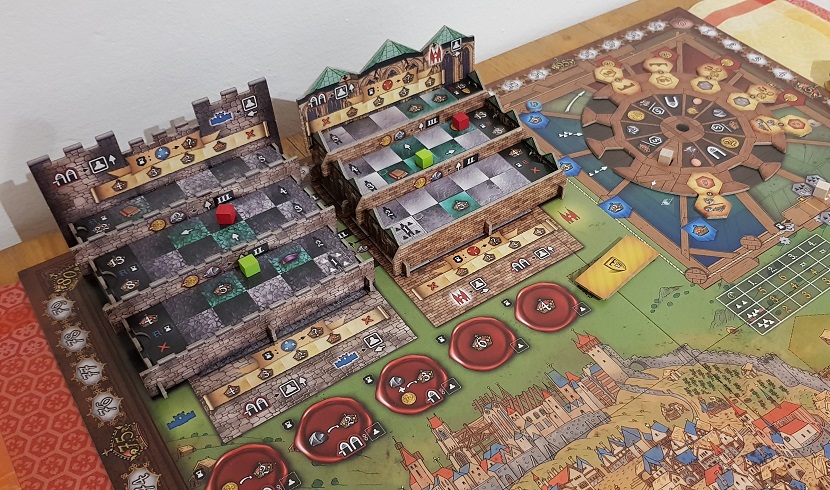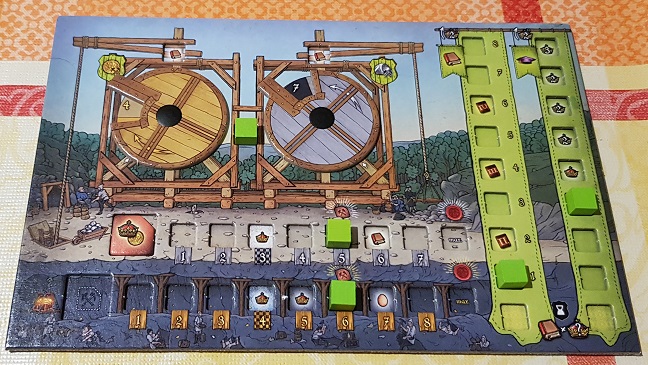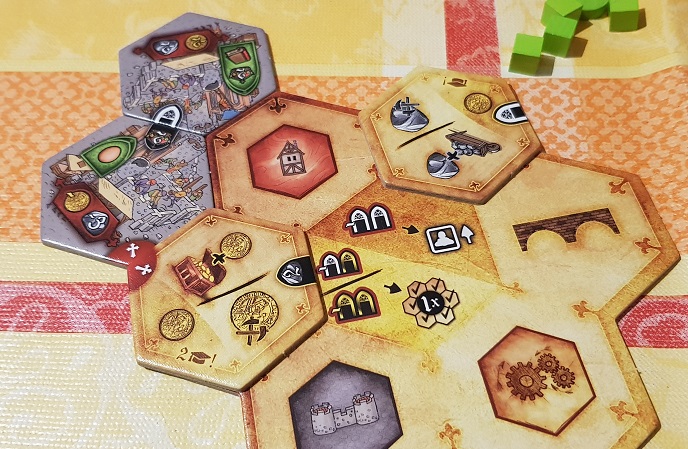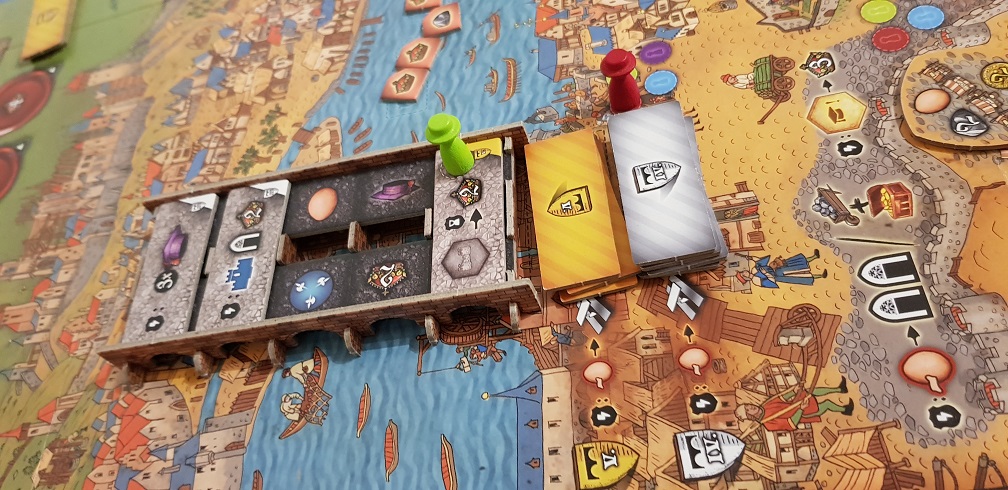Today’s Praga Caput Regni Board Game Review treats the 2020 title from Delicious Games. Does the gameplay match its splendid presentation?
Introduction to Praga Caput Regni Board Game Review
14th Century was an era of great development in Prague. Charles IV has been crowned as the Holy Roman Emperor and he’s started many large-scale projects in the capital, that stand tall to this day. A bridge that will bear his name, St. Vitus Cathedral, Hunger Wall, as well as the city and its castle.
You play as lords of the city and your task is to coordinate these undertakings the best you can. The one who impresses the Emperor the most (read: collects the most victory points), will be the winner.

Theme, Presentation, and Components: an Ode to Prague
The theme is one of the strongest points of Prague. It shows that the developers went beyond what would be necessary for a functional game. There’s a historical section in the rulebook, the mechanics feel connected to the theme (i.e. per legend eggs were used as an ingredient for the bridge, you now need eggs to advance on the King Road/Bridge track), rotating cranes are used as resource counters and action selector, etc.
The feel of immersion is further enhanced by the splendid components. The large central board is an actual map of Prague, with certain landmarks in the right spots and many tiny details portrayed. The 3D components (Bridge, Cathedral, and Wall) are majestic, as are the dual-layered player boards and all the moving cranes.
One thing to note is that the central board is very large. This can be a problem if your playing space is limited, as well as during the game. It can be difficult to see details on the other side of it. It gets better after a few plays when you know where everything is, but for initial games, it can be annoying.
And all components are made of cardboard, there’s no sign of plastic anywhere! Not only is that more environmentally friendly, but it also keeps the costs down. Yes, there is a lot of stuff in the box and it took me an hour to punch it all out and assemble the structures. But the process was very satisfying to do.
If one of my main criticism of the publisher’s previous title, Underwater Cities, was the underdevelopment of the theme, In Praga, it is a 10/10. If you like history and are in any way connected to Prague (or have even been there), you will love this game. The developers poured a lot of effort and passion into it.
More historically accurate board games:
Setup and Rulebook
The setup is relatively quick. The only thing that may take a bit more time is to sort out all the tokens and set them up on the board. If you store them separated (plastic bags that are included suffice), this shouldn’t be a big deal.
I appreciated the rulebook very much. It’s very well structured, with a lot of illustrations and examples. I had absolutely no trouble learning the game. Moreover, the rulebook is esthetically very pleasing and it comes with the aforementioned History section. All of that helps with the immersion.

Gameplay
Praga is a game of resource management. You use stone and gold to perform one of the six basic actions:
- add a Building tile to the board,
- add a Wall tile around your action board,
- Upgrade an action on your action board,
- manage or produce gold,
- manage or produce stone,
- and advance on the King Road.
So far, all is simple. Now comes the fun part. You must take your desired action from the action crane. It prices the actions, so that those that have not been taken for a while, can give you a point bonus. On the other hand, if you want a recently taken action, you will have to pay gold.
Woodcraft uses a similar action-selection wheel
The second purpose of the crane is that it acts as a hard cap on the number of rounds. You get 16 regular actions and that’s it. So you need to make them count.
Therefore, the trick is to make your actions as effective as possible and chain multiple bonuses together. Bonuses can be anything from extra resources, special resources (such as windows or eggs), adjacency tokens, permanent upgrades and abilities, and so on.
A few examples
Firstly, you always get a bonus from the action crane when you take an action tile. Follow up bonuses depend on the action:
- If you construct a building, you must pay its cost and take the immediate reward on the tile. You then place it on the board, which can trigger further bonuses. If corners match, you get an adjacency. You also compete for bonuses of the adjacent plaza or score immediate points. Moreover, you can get extra points (for an extra cost) if you do all that north of King’s Road.
To top it off, if your building has a Cathedral icon, you can also move sideways on the Cathedral track, possibly triggering further bonuses. - It’s very similar to constructing Walls, but you build those around your action board and they allow you to move sideways on the Wall track.
- Walls adjacency bonuses can also get completed with upgraded action tiles (since you place them next to each other). These grant ongoing bonuses for future actions of that type.
- Managing gold and stone, you can potentially unlock special abilities, permanent production bonuses, technologies, seals that help with end scoring, or even precious golden windows.
- King’s Road is particularly generous with bonuses, especially towards the Bridge. But you need eggs to take the full benefit of it.
Moving sideways on Cathedral or Wall increases the end-game payout for your adjacency tokens, but for some real points, you must move upwards. You do that by spending a pair of silver windows. You’ll usually want to combine both movements in a way, that will allow you to collect many bonuses on the way up.
Then there are the golden windows, the most precious resource in the game. These allow you to take an extra action of your choice. As the game is limited to just 16 turns, you can understand how powerful a possible extra action is. It’s basically an extra turn.
To summarize, Praga is a combination of resource management, action selection, tile placement, and advancement on several tracks. Your actions will trigger many bonuses, which you will use as resources for further actions.

Can you handle the chain of bonuses coming your way?
This bonus upon bonus mechanic is very fun and satisfying. There are a lot of possibilities and things you can trigger, so you need to think your actions through. Even though there are only six basic actions, it’s this chaining of bonuses and actions that force you to carefully plan your turns.
If you, like me, enjoy the combos in board games, you will really love Praga. The feel when just a simple action triggers an almost game-breakingly powerful chain of events is what we play board games for. In that aspect, Praga is every combo-lovers galore.
Although sometimes the bonuses the game throws at you are just too much. It can be hard to keep a track of everything you gained in a single turn. I often found myself doing small checklists in my mind: take the crane bonus, pay the costs, gain the immediate rewards, check for adjacency bonuses, keep in mind the permanent special abilities, and so on. You don’t want to forget anything.
With that in mind, you’ll always want to take the action that will give you the most benefit at the moment, only thinking 1 or 2 turns in advance. This makes your decisions predominantly tactical. You can’t really implement any long-term strategy, since the state of available actions changes so much from turn to turn.
Also, since there are a lot of points to be gained on every track, you can’t afford to neglect any. So you always end up doing a bit of everything, rather than focusing on one or two things. Because of these two reasons, the games of Praga Caput Regni feel kind of the same to one another, despite the setup having a lot of variables and mods.
Still, the process of contemplating various actions is a lot of fun, the sense of progression is present (your starting turns will be very short compared to the later ones), and the satisfaction from a decent chain of actions is fulfilling.
More action-packed eurogames:
Scalability, Playing Time, and Player Interaction
Praga Caput Regni plays fine with all player counts, 1-4. The board is slightly adjusted for different player counts so that the competition for spaces around plazas is always tight.
The playing time is around 30-40 minutes per player. This means that a 4 player game can last a bit too long, particularly if you have analysis-paralysis prone players. This is not helped by the fact that there isn’t much to do when it’s not your turn. The downtime is best spent helping other players keep track of their turns.
There is some healthy player interaction: competition for action tiles, plazas, buildings, scoring tiles and seals, etc. There’s just enough that you have to be aware of what others are doing, but it doesn’t ruin your enjoyment if another player takes a tile you were aiming for. There’s always an alternative.

Single-Player Mode
A good solo mode is pretty much mandatory in board gaming these days and Praga doesn’t disappoint here. You play simply for a high score, which is an excellent tool to practice game mechanics and different approaches, as well as a tough challenge.
There’s a print-and-play modification that adds a bit more interaction on the AI side, but also a tad more upkeep. It’s five cards to print and make, so not a big hassle. It works fine, but I’d like to see it added to the base game by default.
Conclusion
I’ve enjoyed playing Praga Caput Regni very much. Its superb presentation and very crunchy gameplay lured me back again and again. As someone who’s been to Prague in RL (loved every minute of it), the theme really came through and lifted my experience to the next level.
It’s hard to tell if the appeal is going to last long enough to make this one of my all-time greats, but so far it looks good. Our Czech brethren have done a remarkable job with this game and I just want to go back and play it again right now.

